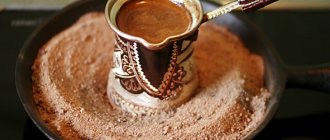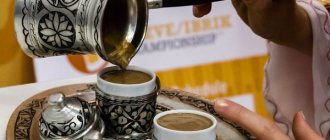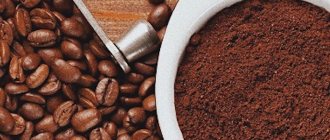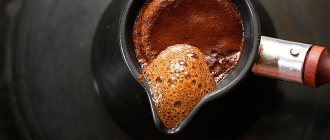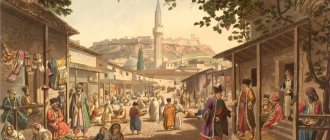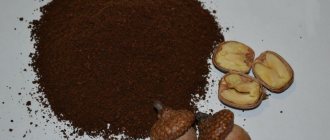The taste and aroma qualities of a coffee drink depend primarily on the type of beans chosen. Also, these characteristics are influenced by what the coffee is brewed in. There are several types of cookware and devices that can be used. To achieve good results, it is extremely important to choose these devices correctly.
What is coffee usually brewed in?
There is more than one name for cookware for making coffee. In the United States of America alone, about eight hundred patents have been issued for various variations of coffee makers. Essentially, all these devices are divided into two types:
- electrical;
- slab
Slabs require heating. The dishes are placed on the stove. Electric ones simply need to be connected to the mains.
There are both simple devices that have been used for centuries, and modern units that perform many functions, including grinding beans and choosing the optimal dosage.
Cooking in Turk
The oldest and simplest way to prepare a coffee drink, which is still widely used today, is boiling the beans in a Turk (cezve). Already from the name it becomes clear that this dish was invented in eastern countries. They initially used ordinary saucepans to brew the drink, and then for convenience they decided to remove one of the handles. The one that remained was made longer, curved and flattened.
Over time, the Arabs noticed that if the container at the neck was made narrower and the edges widened, the coffee would be much tastier. Thus, dishes with a thickened bottom, a narrow neck and a long handle were invented. She quickly gained popularity all over the world.
Nowadays, Turkish coffee is prepared on a stove (gas or electric). The classic recipe involves brewing in hot sand. The following actions are performed:
- The sand is heated for several hours.
- A Turk filled with coffee and water is immersed in it up to the level of the neck.
- When the water approaches the point of boiling, the cezve is quickly removed.
- To fully develop the taste and aroma, such manipulations are repeated 3-4 times.
For those who like to prepare a drink according to the classic recipe, a special electrical appliance has been developed. Visually, it resembles a box filled with sand. When it is turned on, the contents of the container become hot. All that remains is to place the cezve there.
If you have no experience in making coffee, it is recommended to start mastering this process with a copper or ceramic Turk.
Initially, only one type of grain is used. Then you can switch to mixtures and add various spices to the composition.
Cezva (Turkish)
The cezve (Fig.

This is how the cezve was born - a thick-walled ladle with a narrow neck and a comfortable straight handle. Since Turkey at that time was one of the most powerful states in the world, coffee, the method of preparing it and the name of the coffee pot - cezve - became known almost throughout Europe. But in the Arab countries of the Mediterranean, the coffee cezve is called “rakwa”.
Another name for the cezve, the Turk, has also stuck in Russia: the ladle came from Turkey. In Serbia, Bulgaria, the Czech Republic, Poland and most Eastern European countries (except Romania), this coffee pot is called a cezve.
In Western Europe, cezves are not particularly popular: the indigenous people prefer coffee makers. Therefore, for example, in Germany, not every seller will understand if a buyer asks him about a cezve. The Germans more often call it kaffeekännchen (“coffee jug”).
In France, the term cezve turque (“Turkish cezve”) is used. In the Cypriot dialect of Greek, the vessel is called not only cezve, but also “briki” (μπρίκι) - from the Arabic “ibrik”. In all English-speaking countries, including the USA, as well as in Romania, the cezve is called “ibrik” and nothing else.
To avoid confusion, at international coffee-making competitions they always write and announce “cezva/ibrik” or “cezva/ibrik/turk”. Many well-known online stores, including Amazon, indicate this in the product descriptions. Therefore, some coffee lovers have the opinion that cezve and ibrik are synonymous. There was even a tendency to call all vessels for brewing coffee Turks.
Coffee pot
This coffee brewing container was invented in England at the end of the eighteenth century. Since then, the simple device has been constantly improved. Some coffee pots are used by brewing the beans on the stove, while others run on electricity. Despite many new, more modernized designs, these continue to remain popular among coffee lovers.
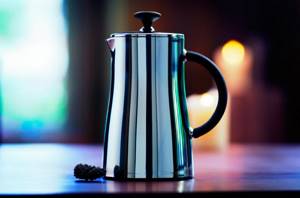
Turk, aka cezve
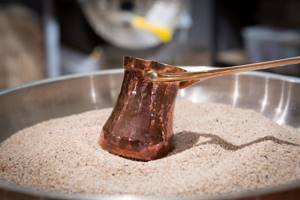
Cost of equipment: from 500 rubles; Cooking time: 5-6 minutes to cook and 5-6 minutes to settle; You can prepare one or two servings.
You probably already have a Turk in your home and you probably don’t use it often, because to make delicious coffee in a Turk you need to know a few secrets. The first is an extremely fine grind, in which the coffee falls out of the grinder in clumps, rather than pouring out like sand. Unfortunately, the required grind is almost impossible to achieve with home coffee grinders. From the experience of our coffee shops, I can say that good grinding is provided by professional burr coffee grinders for espresso, the cost and size of which do not allow their use at home.
The best way to prepare Turka is in the sand, the heat evenly warms the coffee throughout the entire volume, the drink does not burn, and is prepared quickly enough. Sand takes a long time to heat up, this almost eliminates the possibility of cooking Turka on sand in the morning. There will definitely be difficulties with cooking a Turk on an induction stove - a copper Turk will ignore induction and will never heat up. You can deceive it by placing it on a steel frying pan that is on the stove. The main thing is not to drop this architectural invention in your sleep.
In stores you can find Turkish coffee pots for one, two or even five cups, but remember that a large-volume Turkish coffee pot will require a long time to warm up, which means the coffee will be over-extracted and begin to taste bitter. Therefore, I recommend cooking Turk in portions. One cup - one Turk. During cooking, the Turk requires your continuous attention, otherwise you will have to spend effort on cleaning.
The drink in the Turk turns out dense or, as coffee professionals say, dusty, but the method leaves room for experimentation - heat a piece of star anise, cloves or a drop of spices in the Turk before preparing coffee and your drink will sparkle with new colors.
French press coffee maker
Invented in France in 1920, the device for brewing coffee is very popular. The coffee maker looks like a tall glass container made of high-temperature resistant material. Equipped with a piston. The lower part of this design part is connected to a metal filter, which looks like an ordinary mesh and fits tightly to the glass walls. At the top, the piston is attached to the cover.
The device is heated, and then coarsely ground coffee beans are poured into it and hot water is poured. After five minutes, the piston is slowly lowered down. Due to this, there is no grounds in the finished drink.
Classification
The assortment of modern tableware includes many varieties of coffee pots. They are made from different materials, differ in thermal conductivity, features and duration of operation, and cost. In order for your purchase to meet all expectations, you need to understand the key advantages and disadvantages of common types.
By heating method
Depending on the characteristics of heating coffee, there are 4 main models of Turks.
| Types of Turks for making coffee | What is | Advantages | Flaws |
| Classical | A traditional trapezoidal product designed for brewing coffee on a gas stove or hot sand | Suitable for preparing coffee according to any recipe | The disadvantages directly depend on the material from which the Turk is made |
| Electric | Connects to the mains. Provides a larger volume than similar products and is equipped with various sensors and indicators | Requires minimal time to prepare a drink - from 30 to 60 seconds, takes up little space, easy to use | The appliance must be descaled regularly. The taste of the finished drink is inferior to coffee brewed in a classic Turk |
| For glass ceramics | A classic-shaped Turk made of ceramic, clay, glass or porcelain with a thick, flat bottom | The glass-ceramic stove heats up for a long time, which allows you to fully reveal the taste of coffee | A Turk that is not removed from the stove in a timely manner quickly becomes unusable. |
| For induction cooker | Such Turks are made of ferromagnetic alloys, mainly steel | A model purchased specifically for an induction panel can be used on other hobs | The bottom area of the Turk should cover at least 70% of the burner. An additional adapter is required for even heating |
A proper coffee pot must meet the basic requirements: wide bottom, narrow neck, material with high thermal conductivity. All other factors depend on the operating conditions of the product.
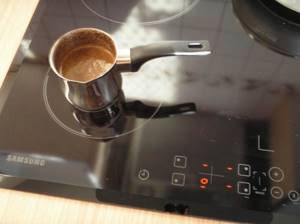
For induction cooker
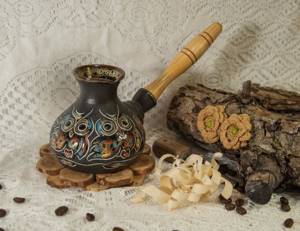
For glass ceramics
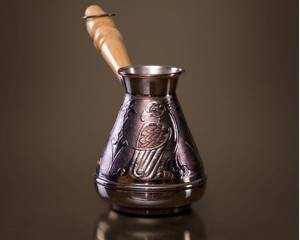
Classical
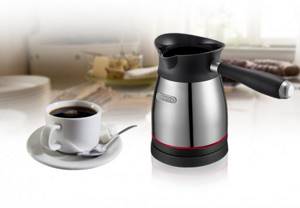
Electric
By volume
The capacity of the dishes is an important criterion. To find out which Turk is better to buy, you need to decide on the number of people who will use it. The classic option is a 100 ml cezve. It will only be enough for one person, because when the liquid boils there should be room for the rising foam. Accordingly, 1–2 teaspoons of ground coffee are poured into 50–75 ml of water. For 2-3 family members, it is worth considering options for 350-500 ml. For more people, the 750 ml Turk will become indispensable.
The water level should be close to the neck of the product, so it is not recommended to brew one portion of coffee in a large Turk - this way the foam plug will not be dense or will not form at all.
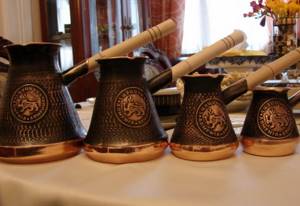
By design
It is necessary to choose a coffee pot based on its shape, which affects the preparation process and the taste of the drink:
- Conical. With a wide bottom and tapering sides that hold most of the coffee grounds. The narrow neck ensures the formation of a plug, and the foam catcher prevents spillage. Usually made of copper, brass, aluminum.
- Cylindrical. Heats water unevenly. Due to prolonged exposure to high temperatures on the bottom layer, the usual taste of coffee changes. Turks of this shape are mainly made of steel.
- Barrel-shaped. The manufacturing material for such products is usually ceramics or clay - they maintain the temperature for a long time, providing a more pronounced taste of the drink. However, due to its high heat capacity, the foam may escape even if the ceramic coffee pot is removed from the stove in time.
The optimal wall thickness of a metal Turk is 1.5 mm. Only clay and ceramic products have greater value. Some manufacturers make only the bottom thick, which indicates the connection of the two parts. Such a design often indicates the fragility of the Turks, because due to regular temperature changes, the quality of the seam decreases.
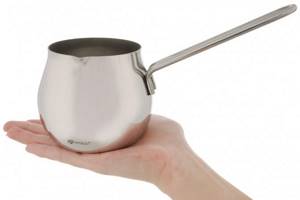
Barrel-shaped
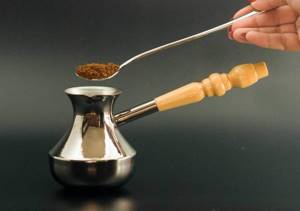
Conical
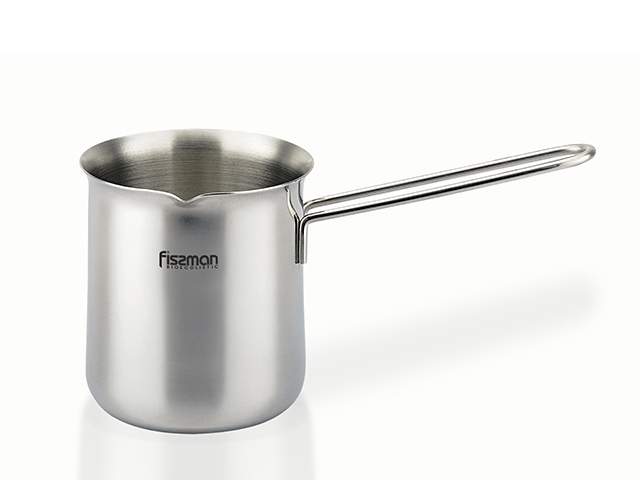
Cylindrical
Geyser coffee maker
This device is especially popular among residents of Italy. The appearance of the unusual invention dates back to 1927.
The structure consists of three elements. The bottom section contains water. Above it is a raw materials compartment. The upper part is intended for the finished drink. To brew coffee, the device is placed on the stove. In this case, strong pressure is generated in the lower part. Steam begins to pass through the crushed grains located in the middle section. After this, it enters the upper compartment, cools down and goes through the condensation stage. The thicket continues to be located in the center of the structure. The drink turns out rich and quite strong.
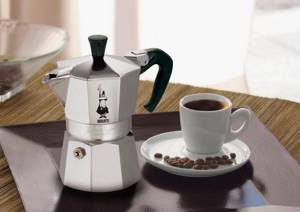
Drip coffee maker
It is very convenient to brew coffee in a drip coffee maker. It is also known as American filtration. The invention appeared thanks to the efforts of the archbishop of Paris in 1800. The device is equipped with a heating circuit through which water moves, which eventually reaches a temperature of about 90-95 degrees. After this, the liquid begins to flow one drop at a time into a filter filled with crushed grains. When the coffee releases its aroma sufficiently, the liquid flows into the flask.
One of the important design details is the filter. It can be disposable (made of paper) or reusable (nylon).
Often, a filter made of nylon is additionally coated with titanium nitrate. Due to this, its service life is significantly extended.
Coffee lovers who prefer a strong coffee drink are recommended to give preference to coffee makers with low power (within 750-850 W). The liquid in such a unit will heat up more slowly and absorb the maximum amount of aromatic substances. This makes the coffee richer.
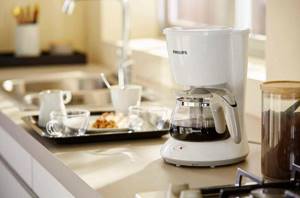
Espresso coffee maker
The drink is prepared using steam pressure. This unit can also make cappuccino. To froth milk, you need to place a straw equipped with a nozzle in a container with liquid. Steam will begin to flow through it under pressure. Due to this, foam will appear on the brewed coffee.
The unit works according to this principle:
- the water gradually warms up;
- when the maximum pressure is reached, the valve opens;
- the liquid moves through the tank containing the grains.
Depending on the device model, you can prepare 2-4 cups at a time. Designs that create a pressure of 15 bar are more advanced than those designed for only 3.5-5 bar. In them, the liquid absorbs a maximum of aromatic substances.
For this type of coffee maker, it is recommended to use a special type of product. It's called espresso. These are coarsely crushed grains that have undergone special heat treatment.
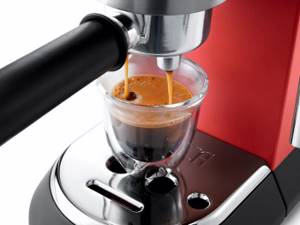
Other ways to make coffee
For brewing, you can use a Turk, geyser, drip coffee maker or carob coffee machine. Coffee capsules are also now available, which are used in special machines, while human participation in preparation is minimized. Some gourmets resort to alternative methods of brewing coffee powder - in a French press, Chemex, siphon, hario and other vessels of unusual shapes.
How to brew coffee in a geyser coffee maker
Geyser coffee makers have gained wide popularity in Europe, largely due to their design, convenience and ease of use.
It works due to steam pressure, and got its name due to the fact that the principle of its operation externally resembles an erupting underground source of hot water. Geyser coffee makers first appeared on the market in the 19th century. Today they are made of aluminum, ceramics and stainless steel, there are electric ones, powered by the network, and traditional ones - those that are placed on the stove, like a kettle.
It is very simple to brew coffee in a geyser coffee maker - you just need to pour water into the lower container and pour ground coffee into the filter. As the water boils, the steam pressure increases, it pushes the water out, passing it through the filter, then the drink passes through a special tube, filling the upper part of the coffee maker.
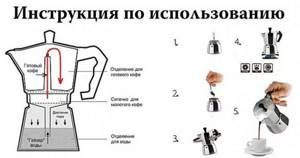
To start brewing, you first need to disassemble the coffee maker into three parts:
- Pour cold water into the bottom one exactly to the mark; it should not be more or less than indicated on the wall of the container.
- Fill the filter with coffee powder - preferably medium grind, and the coffee tablet should be dense, but not too compacted, because this will make it difficult for water to pass through it.
- Then you need to install the lower container and place the assembled coffee maker on the burner (or plug it into an outlet if you are dealing with an electric version).
The drink will be ready as soon as all the water is in the upper container and a characteristic hissing sound is heard.
Combination coffee maker
A combination coffee maker combines two types of devices. One of them is drip type. She is able to prepare a liter of an invigorating drink at once. The other brews just one cup of espresso. Such units are equipped with a special device designed for whipping dairy products.
These designs are suitable for coffee lovers who find it difficult to decide on their preferences and choose between espresso or traditional coffee. They are convenient to use in a small kitchen. Such devices save space.
These coffee makers also have disadvantages. Among them are the following:
- each part of the unit requires special care;
- you have to purchase different types of ground grains;
- high price. For the same money you can buy an espresso and drip device of decent quality separately.
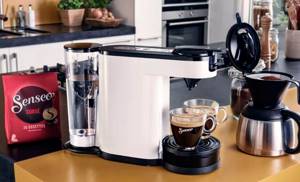
There are a huge number of devices designed for brewing coffee. Each of them has a number of advantages and disadvantages. It is impossible to say unequivocally what is best to brew coffee beans in. Disputes on this matter continue constantly. Some people prefer the drink prepared in a cezve or French press. Other coffee lovers claim that it is much easier to brew it in modern units.


